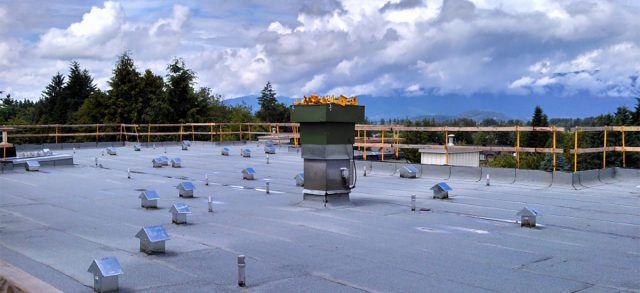Commercial roofing and residential roofing can be very different animals. While project types ultimately have the same goals – to prevent water from getting in, to protect the structure, and to optimize heat retention in winter – the differences between homes and commercial buildings mean that very different approaches to roofing may be called for.
Commercial roofs are often larger, flatter, and may need to support foot traffic and roof-mounted installations. Some roofing options that may be attractive and appropriate for small, sloped-roof houses won’t work on commercial buildings at all.
Here’s a short guide to the major types of commercial roofing, including the advantages and disadvantages of each type, as well as some maintenance tips.
Single-Ply Roofing
Single-ply roofing refers to flexible sheets of plastic membranes that can be attached to the roof using various methods. The three main types of single-ply roofing material are TPO (thermoplastic polyolefin), PVC (polyvinyl chloride), and EPDM (ethylene propylene diene monomer). However, many professionals recommend TPO as the best choice for single-ply roofing, as it rates the highest in terms of puncture and weather resistance, solar reflectivity, and sustainability.
Advantages:
- Lightweight and pliable
- Easy to install and repair
- Lighter-colored, reflective single-ply materials can significantly reduce heating costs
Disadvantages:
- May retain water
- Easy to puncture
- May not last as long as other roofing options
Maintenance:
- Regularly inspect for debris, leaks, and damage
- Watch out for loose or protruding fasteners
- Inspect twice a year, in the spring and fall
Torch-On Roofing
Sometimes called torch-down, asphalt roll, or rubberized asphalt roofing, torch-on roofing consists of asphalt and resin layers that are applied to the roof by melting them together with a torch. This results in a lightweight, weather-resistant roof that will hold up well for many years. Torch-on roofing is best suited for low-angle or flat roofing.
Advantages:
- Cost-effective compared to other commercial roofing types
- Blocks heat, rain, and UV rays
- Extremely durable and can last 25 years or more with regular maintenance
- Heat and UV protection can result in improved energy efficiency and lower heating costs (some torch-on roofs can even qualify for LEED credits)
- Installation process does not require hot tar kettles
- Provides a completely waterproof seal, preventing roof leaks even during heavy storms
- While yearly checks are recommended, torch-on roofing requires fairly low maintenance, making it a very cost-effective option
- Easy to modify if you want to add a skylight or other roof features
Disadvantages:
- Not a DIY project – torch-on roofing requires skilled installers
- The initial installation cost can be higher than other commercial roofing methods
Maintenance:
- Regularly inspect for debris, leaks, and damage
- A qualified roofing professional should perform an inspection every year
Metal Roofing
Metal roofing continues to find favor in commercial projects because it is lightweight, durable, and sheds rain and snow easily. It comes in a wide variety of options, with various material choices (including steel, aluminum, zinc, and even copper, if you’re willing to pay the hefty price) and application methods (standing seam, tile, panels, and more).
Advantages:
- Very resistant to fire
- Aesthetically pleasing
- Low-maintenance and long-lived; metal roofs can last up to 50 years if installed properly
- Moss and mold resistant
- Not easily damaged by wind, weather, or falling debris
Disadvantages:
- Initial installation can be expensive
Maintenance:
- While metal roofs should be regularly inspected for damage, they do not require significant routine maintenance
Built-Up Roofing
This roofing type has been in use for many years as the familiar tar-and-gravel roof seen on many older commercial buildings. It consists of several layers of material laminated together: a base sheet (fiberglass or asphalt-coated), felts or fabrics, bitumen (asphalt or coal tar), and a surfacing component (gravel, asphalt, or other coatings).
Advantages:
- Durable and long-lasting, easily able to withstand heavy foot traffic
- With many layering options, built-up roofing is versatile and adaptable to a wide range of roof deck types and climates
- Highly weather-resistant and leak proof
Disadvantages:
- Installation takes a long time and can involve materials that give off noxious fumes
- Heavy roofing materials can add extra weight to the building structure
- Harder to inspect & find leaks
Maintenance:
- The gravel layer must be inspected in order to prevent UV rays from breaking down the sublayers
A Seasonal Reminder: Commercial Roofing in the Wintertime
Whether you already have a roof installed on your commercial building, are looking to replace an existing roof, or need to figure out the best option for a building under construction, keep in mind that all roofs – even tough commercial roofs – need a little extra TLC in the wintertime.
Here are a few things you can do to help prepare your roof for bad weather and reduce the chances that you’ll end up needing emergency roof repair:
- Clean out all gutters and drainage ports
- Remove debris, including bird nests
- Inspect thoroughly for damage, especially around seams, joints, flashing, and other structural elements
- Trim trees that may shed leaves and branches onto the roof or into gutters
Proper maintenance can greatly extend the life of any type of roof, and, in most climates, winter is when roofs are at greatest risk of suffering wear and damage.
Whichever type of roofing you choose for your commercial project, remember that regular inspections and maintenance from professionals are the most cost-effective way to make your roof last as long as possible, while minimizing the need for expensive repairs or whole-roof replacement.

